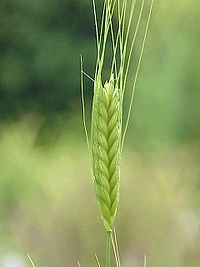
Photo from wikipedia
The wheat semi-dwarfing genes Rht (Reduced height) are widely distributed among the contemporary wheat varieties. These genes also exert pleiotropic effects on plant tolerance towards various abiotic stressors. In this… Click to show full abstract
The wheat semi-dwarfing genes Rht (Reduced height) are widely distributed among the contemporary wheat varieties. These genes also exert pleiotropic effects on plant tolerance towards various abiotic stressors. In this work, frost tolerance was studied in three near-isogenic lines of the facultative variety ‘April Bearded’ (AB), carrying the wild type allele Rht-B1a (tall phenotype), and the mutant alleles Rht-B1b (semi-dwarf) and Rht-B1c (dwarf), and was further compared with the tolerance of a typical winter type variety, ‘Mv Beres’. The level of freezing tolerance was decreasing in the order ‘Mv Beres’ > AB Rht-B1a > AB Rht-B1b > AB Rht-B1c. To explain the observed differences, cold acclimation-related processes were studied: the expression of six cold-related genes, the phenylpropanoid pathway, carbohydrates, amino acids, polyamines and compounds in the tricarboxylic acid cycle. To achieve this, a comprehensive approach was applied, involving targeted analyses and untargeted metabolomics screening with the help of gas chromatography/liquid chromatography—mass spectrometry setups. Several cold-related processes exhibited similar changes in these genotypes; indeed, the accumulation of eight putrescine and agmatine derivatives, 17 flavones and numerous oligosaccharides (max. degree of polymerization 18) was associated with the level of freezing tolerance in the ‘April Bearded’ lines. In summary, the mutant Rht alleles may further decrease the generally low frost tolerance of the Rht-B1a, and, based on the metabolomics study, the mechanisms of frost tolerance may differ for a typical winter variety and a facultative variety. Present results point to the complex nature of frost resistance.
Journal Title: International Journal of Molecular Sciences
Year Published: 2022
Link to full text (if available)
Share on Social Media: Sign Up to like & get
recommendations!